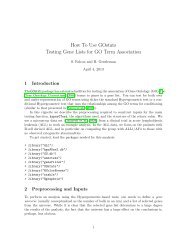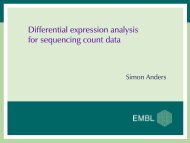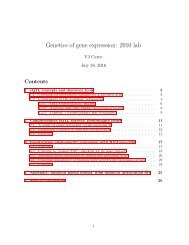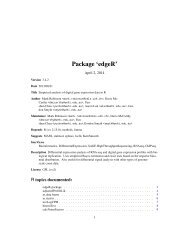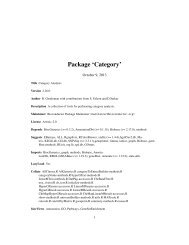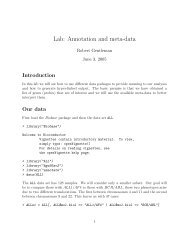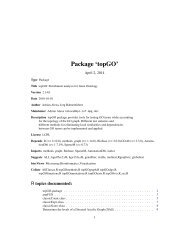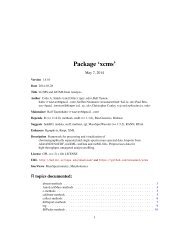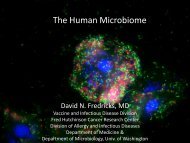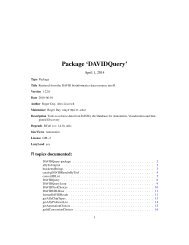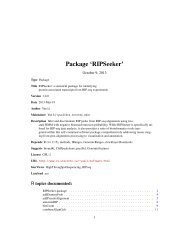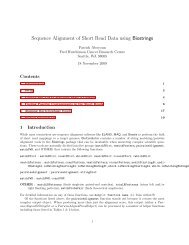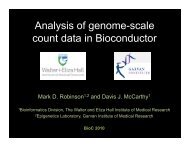Package 'gage' - Bioconductor
Package 'gage' - Bioconductor
Package 'gage' - Bioconductor
Create successful ePaper yourself
Turn your PDF publications into a flip-book with our unique Google optimized e-Paper software.
<strong>Package</strong> ‘gage’<br />
April 2, 2014<br />
Type <strong>Package</strong><br />
Title Generally Applicable Gene-set Enrichment for Pathway Analysis<br />
Version 2.12.3<br />
Date 2014-3-14<br />
Author Weijun Luo<br />
Maintainer Weijun Luo <br />
Description GAGE is a published method for gene set (enrichment or GSEA) or pathway analysis.<br />
GAGE is generally applicable independent of microarray or RNA-Seq data attributes including<br />
sample sizes, experimental designs, assay platforms, and other types of heterogeneity,<br />
and consistently achieves superior performance over other frequently used methods.<br />
In gage package, we provide functions for basic GAGE analysis, result processing and presentation.<br />
We have also built pipeline routines for of multiple GAGE analyses in a batch, comparison<br />
between parallel analyses, and combined analysis of heterogeneous data from different<br />
sources/studies. In addition, we provide demo microarray data and commonly<br />
used gene set data based on KEGG pathways and GO terms. These funtions<br />
and data are also useful for gene set analysis using other methods.<br />
biocViews Pathways, GO, DifferentialExpression, Microarray,OneChannel, TwoChannel,<br />
RNAseq, Genetics, MultipleComparisons,GeneSetEnrichment<br />
Depends R (>= 2.10)<br />
Imports graph, KEGGREST<br />
Suggests pathview, gageData, GO.db, org.Hs.eg.db, hgu133a.db,GSEABase, Rsamtools,<br />
TxDb.Hsapiens.UCSC.hg19.knownGene, DESeq,DESeq2, edgeR, limma<br />
License GPL (>=2.0)<br />
URL http://www.biomedcentral.com/1471-2105/10/161<br />
Collate colorpanel.R deComp.R eg2sym.R esset.grp.R essGene.R<br />
gageComp.R gage-internal.R gagePipe.R gagePrep.R gage.R<br />
gageSum.R geneData.R greenred.R gs.heatmap.R gs.KSTest.R<br />
1
2 eg2sym<br />
gs.tTest.R gs.zTest.R heatmap2.R heter.gage.R invalid.R<br />
kegg.gsets.R kegg.species.code.R odd.R pairData.R readExpData.R<br />
readList.R rownorm.R sigGeneSet.R sym2eg.R vennCounts.R vennDiagram2.R<br />
LazyLoad yes<br />
R topics documented:<br />
eg2sym . . . . . . . . . . . . . . . . . . . . . . . . . . . . . . . . . . . . . . . . . . . 2<br />
egSymb . . . . . . . . . . . . . . . . . . . . . . . . . . . . . . . . . . . . . . . . . . . 4<br />
esset.grp . . . . . . . . . . . . . . . . . . . . . . . . . . . . . . . . . . . . . . . . . . . 5<br />
essGene . . . . . . . . . . . . . . . . . . . . . . . . . . . . . . . . . . . . . . . . . . . 8<br />
gage . . . . . . . . . . . . . . . . . . . . . . . . . . . . . . . . . . . . . . . . . . . . . 10<br />
gageComp . . . . . . . . . . . . . . . . . . . . . . . . . . . . . . . . . . . . . . . . . . 15<br />
gagePipe . . . . . . . . . . . . . . . . . . . . . . . . . . . . . . . . . . . . . . . . . . . 17<br />
geneData . . . . . . . . . . . . . . . . . . . . . . . . . . . . . . . . . . . . . . . . . . 20<br />
gs.tTest . . . . . . . . . . . . . . . . . . . . . . . . . . . . . . . . . . . . . . . . . . . 22<br />
gse16873 . . . . . . . . . . . . . . . . . . . . . . . . . . . . . . . . . . . . . . . . . . 24<br />
heter.gage . . . . . . . . . . . . . . . . . . . . . . . . . . . . . . . . . . . . . . . . . . 25<br />
kegg.gs . . . . . . . . . . . . . . . . . . . . . . . . . . . . . . . . . . . . . . . . . . . 27<br />
kegg.gsets . . . . . . . . . . . . . . . . . . . . . . . . . . . . . . . . . . . . . . . . . . 29<br />
readExpData . . . . . . . . . . . . . . . . . . . . . . . . . . . . . . . . . . . . . . . . 31<br />
readList . . . . . . . . . . . . . . . . . . . . . . . . . . . . . . . . . . . . . . . . . . . 32<br />
sigGeneSet . . . . . . . . . . . . . . . . . . . . . . . . . . . . . . . . . . . . . . . . . 33<br />
Index 36<br />
eg2sym<br />
Conversion between Entrez Gene IDs and official gene symbols for<br />
human genes.<br />
Description<br />
These functions convert Entrez Gene IDs to official gene symbols for human genes, or vise versa.<br />
Usage<br />
eg2sym(eg)<br />
sym2eg(sym)<br />
Arguments<br />
eg<br />
sym<br />
character vector for Entrez Gene IDs (human genes only).<br />
character vector for official gene symbols (human genes only).
eg2sym 3<br />
Details<br />
Currently, only conversion for human genes are supported. Notice that some gene symbols are not<br />
official, hence not recognized and NA will be returned in such cases.<br />
Value<br />
A character vector giving the converted official gene symbols or Entrez IDs.<br />
Author(s)<br />
Weijun Luo <br />
References<br />
Luo, W., Friedman, M., Shedden K., Hankenson, K. and Woolf, P GAGE: Generally Applicable<br />
Gene Set Enrichment for Pathways Analysis. BMC Bioinformatics 2009, 10:161<br />
See Also<br />
egSymb mapping data between Entrez Gene IDs and official symbols; readList read in gene set<br />
list<br />
Examples<br />
#genes in gse16873 was label by Entrez IDs<br />
data(gse16873)<br />
head(rownames(gse16873))<br />
#may convert the gene IDs to official symbols<br />
gse16873.sym
4 egSymb<br />
egSymb<br />
Mapping between Entrez Gene IDs and official symbols<br />
Description<br />
Usage<br />
Format<br />
Details<br />
Source<br />
A two column matrix listing the Entrez IDs and official symbols for all currently known human<br />
genes.<br />
data(egSymb)<br />
The format is: chr [1:40784, 1:2] "1" "10" "100" "1000" ... - attr(*, "dimnames")=List of 2 ..$ :<br />
NULL ..$ : chr [1:2] "eg" "sym"<br />
This mapping matrix is commonly used together with functions eg2sym and sym2eg. Check the<br />
examples below.<br />
This mapping data matrix were compiled using the gene data from NCBI Entrez Gene database.<br />
Similar information can also be derived from <strong>Bioconductor</strong> package org.Hs.eg.db. Please check the<br />
package for more information.<br />
References<br />
Entrez Gene <br />
Examples<br />
#genes in gse16873 was label by Entrez IDs<br />
data(gse16873)<br />
head(rownames(gse16873))<br />
#may convert the gene IDs to official symbols<br />
gse16873.sym
esset.grp 5<br />
hn=grep(HN,cn, ignore.case =TRUE)<br />
dcis=grep(DCIS,cn, ignore.case =TRUE)<br />
gse16873.kegg.p2
6 esset.grp<br />
compare<br />
use.fold<br />
cutoff<br />
use.q<br />
pc<br />
output<br />
outname<br />
make.plot<br />
pdf.size<br />
core.counts<br />
get.essets<br />
bins<br />
bsize<br />
cex<br />
Details<br />
layoutType<br />
name.str<br />
character, which comparison scheme to be used: ’paired’, ’unpaired’, ’1ongroup’,<br />
’as.group’. ’paired’ is the default, ref and samp are of equal length<br />
and one-on-one paired by the original experimental design; ’as.group’, groupon-group<br />
comparison between ref and samp; ’unpaired’ (used to be ’1on1’),<br />
one-on-one comparison between all possible ref and samp combinations, although<br />
the original experimental design may not be one-on-one paired; ’1ongroup’,<br />
comparison between one samp column at a time vs the average of all ref<br />
columns.<br />
Boolean, whether the input gage results used fold changes or t-test statistics as<br />
per gene statistics. Default use.fold= TRUE.<br />
numeric, p- or q-value cutoff, between 0 and 1. Default 0.01 (for p-value). When<br />
q-value is used, recommended cutoff value is 0.1.<br />
boolean, whether to use q-value or not as the pre-selection of a signficant gene<br />
set list. Default to be FALSE, i.e. use the p-value instead.<br />
numeric, cutoff p-value for the overlap between gene sets to be called ’redundant’,<br />
default to 10e-10, may need trial-and-error to find the best value.<br />
boolean, whether output the non-redundant gene set list as tab-delimited text<br />
file? Default to be TRUE.<br />
character, the prefix used to label the output file names when output = TRUE.<br />
boolean, whether to generate the network graph to visualize the redundancy<br />
(overlap in core genes) between significant gene sets. Currently the only feasible<br />
option is FALSE.<br />
numeric vector of length 2, spcifies the PDF file size for network graph outpout.<br />
Currently unsupported.<br />
Currently unsupported.<br />
Currently unsupported.<br />
Currently unsupported.<br />
Currently unsupported.<br />
Currently unsupported.<br />
Currently unsupported.<br />
numeric vector of length 2, specifies the substring range of the gene set name to<br />
show in the network graph. Currently unsupported.<br />
... extra arguments to be passed into internal function make.graph. Currently unsupported.<br />
Redundant gene sets are defined to be those overlap heavily in their effective member gene lists<br />
or core genes. Core genes are those member genes that really contribute to the signficance of the<br />
gene set in GAGE analysis in the interesting direction(s). Argument pc set the cutoff for the overlap<br />
to be called "redundant". The redundancy between gene sets is then represented by a undirected<br />
graph/network. Groups of redundant gene sets are then derived as the connected component in the<br />
network graph.
esset.grp 7<br />
Value<br />
The selection criterion for gene sets here is p-value, instead of the commonly used q-value. This<br />
is because for extracting a non-redundant list of signficant gene sets, p-value is relative stable, but<br />
q-value changes when the total number of gene sets being considered changes. Of course, q-value<br />
is also a sensible selection criterion, when one take this step as a further refinement on the list of<br />
signficant gene sets.<br />
The value returned by pairData is a list of 7 elements:<br />
essentialSets<br />
setGroups<br />
allSets<br />
setGroups<br />
overlapCounts<br />
overlapPvals<br />
coreGeneSets<br />
character vector, the non-redundant signficant gene set list.<br />
list, each element is a character vector of a group of redundant gene sets.<br />
character vector, the full list of signficant gene sets.<br />
list, each element is a character vector of a connected component in the redundancy<br />
graph representation of the gene set.<br />
numeric matrix, the overlap core gene counts between the signficant gene sets.<br />
numeric matrix, the significance (in p-values) of the overlap core gene counts<br />
between the signficant gene sets.<br />
list, each element is a character vector of the core genes in a significant gene set.<br />
Author(s)<br />
Weijun Luo <br />
References<br />
Luo, W., Friedman, M., Shedden K., Hankenson, K. and Woolf, P GAGE: Generally Applicable<br />
Gene Set Enrichment for Pathways Analysis. BMC Bioinformatics 2009, 10:161<br />
See Also<br />
gage the main function for GAGE analysis; sigGeneSet significant gene set from GAGE analysis;<br />
essGene essential member genes in a gene set;<br />
Examples<br />
data(gse16873)<br />
cn=colnames(gse16873)<br />
hn=grep(HN,cn, ignore.case =TRUE)<br />
dcis=grep(DCIS,cn, ignore.case =TRUE)<br />
data(kegg.gs)<br />
#kegg test for 1-directional changes<br />
gse16873.kegg.p
8 essGene<br />
gse16873, gsets = kegg.gs, ref = hn, samp = dcis,<br />
test4up = TRUE, output = TRUE, outname = "gse16873.kegg.up", make.plot = FALSE)<br />
gse16873.kegg.esg.dn
essGene 9<br />
compare<br />
use.fold<br />
rank.abs<br />
use.chi<br />
chi.p<br />
character, which comparison scheme to be used: ’paired’, ’unpaired’, ’1ongroup’,<br />
’as.group’. ’paired’ is the default, ref and samp are of equal length<br />
and one-on-one paired by the original experimental design; ’as.group’, groupon-group<br />
comparison between ref and samp; ’unpaired’ (used to be ’1on1’),<br />
one-on-one comparison between all possible ref and samp combinations, although<br />
the original experimental design may not be one-on-one paired; ’1ongroup’,<br />
comparison between one samp column at a time vs the average of all ref<br />
columns.<br />
Boolean, whether the input gage results used fold changes or t-test statistics as<br />
per gene statistics. Default use.fold= TRUE.<br />
boolean, whether to sort the essential gene data based on absoluate changes.<br />
Default to be FALSE.<br />
boolean, whether to use chi-square test to select the essential genes. Default to<br />
be FALSE, use the mean plus standard deviation of all gene changes instead.<br />
Check details for more information.<br />
numeric value between 0 and 1, cutoff p-value for the chi-square test to select<br />
the essential genes. Default to 0.05.<br />
... other arguments to be passed into the inside gagePrep function.<br />
Details<br />
There are two different criteria for essential gene selection. One uses a chi-square test to determin<br />
whether the change of a gene is more than noise. A second considers any changes beyond 1 standard<br />
deviation from mean of all genes as real.<br />
Note that essential genes are different from core genes considered in esset.grp function. Essential<br />
genes may change in a different direction than the overall change of a gene set. But core genes need<br />
to change in the in the interesting direction(s) of the gene set test.<br />
Value<br />
A expression data matrix extracted for the essential genes, with similar structure as exprs.<br />
Author(s)<br />
Weijun Luo <br />
References<br />
Luo, W., Friedman, M., Shedden K., Hankenson, K. and Woolf, P GAGE: Generally Applicable<br />
Gene Set Enrichment for Pathways Analysis. BMC Bioinformatics 2009, 10:161<br />
See Also<br />
gage the main function for GAGE analysis; geneData output and visualization of expression data<br />
for selected genes; esset.grp non-redundant signcant gene set list;
10 gage<br />
Examples<br />
data(gse16873)<br />
cn=colnames(gse16873)<br />
hn=grep(HN,cn, ignore.case =TRUE)<br />
dcis=grep(DCIS,cn, ignore.case =TRUE)<br />
#kegg test for 1-directional changes<br />
data(kegg.gs)<br />
gse16873.kegg.p
gage 11<br />
TRUE, compare = "paired", use.fold = TRUE, weights = NULL, full.table =<br />
FALSE, use.stouffer=TRUE, ...)<br />
Arguments<br />
exprs<br />
gsets<br />
ref<br />
samp<br />
set.size<br />
same.dir<br />
compare<br />
rank.test<br />
use.fold<br />
FDR.adj<br />
an expression matrix or matrix-like data structure, with genes as rows and samples<br />
as columns.<br />
a named list, each element contains a gene set that is a character vector of gene<br />
IDs or symbols. For example, type head(kegg.gs). A gene set can also be a<br />
"smc" object defined in PGSEA package. Please make sure that the same gene<br />
ID system is used for both gsets and exprs.<br />
a numeric vector of column numbers for the reference condition or phenotype<br />
(i.e. the control group) in the exprs data matrix. Default ref = NULL, all columns<br />
are considered as target experiments.<br />
a numeric vector of column numbers for the target condition or phenotype (i.e.<br />
the experiment group) in the exprs data matrix. Default samp = NULL, all<br />
columns other than ref are considered as target experiments.<br />
gene set size (number of genes) range to be considered for enrichment test. Tests<br />
for too small or too big gene sets are not robust statistically or informative biologically.<br />
Default to be set.size = c(10, 500).<br />
boolean, whether to test for changes in a gene set toward a single direction (all<br />
genes up or down regulated) or changes towards both directions simultaneously.<br />
For experimentally derived gene sets, GO term groups, etc, coregulation is commonly<br />
the case, hence same.dir = TRUE (default); In KEGG, BioCarta pathways,<br />
genes frequently are not coregulated, hence it could be informative to let<br />
same.dir = FALSE. Although same.dir = TRUE could also be interesting for<br />
pathways.<br />
character, which comparison scheme to be used: ’paired’, ’unpaired’, ’1ongroup’,<br />
’as.group’. ’paired’ is the default, ref and samp are of equal length<br />
and one-on-one paired by the original experimental design; ’as.group’, groupon-group<br />
comparison between ref and samp; ’unpaired’ (used to be ’1on1’),<br />
one-on-one comparison between all possible ref and samp combinations, although<br />
the original experimental design may not be one-on-one paired; ’1ongroup’,<br />
comparison between one samp column at a time vs the average of all ref<br />
columns.<br />
For PAGE-like analysis, the default is compare=’as.group’, which is the only<br />
option provided in the original PAGE method. All other comparison schemas<br />
are set here for direct comparison to gage.<br />
rank.test: Boolean, whether do the optional rank based two-sample t-test (equivalent<br />
to the non-parametric Wilcoxon Mann-Whitney test) instead of parametric<br />
two-sample t-test. Default rank.test = FALSE. This argument should be used<br />
with respect to argument saaTest.<br />
Boolean, whether to use fold changes or t-test statistics as per gene statistics.<br />
Default use.fold= TRUE.<br />
Boolean, whether to do adjust for multiple testing as to control FDR (False<br />
dicovery rate). Default to be TRUE.
12 gage<br />
Details<br />
weights<br />
full.table<br />
saaPrep<br />
saaTest<br />
saaSum<br />
rawRes<br />
test4up<br />
a numeric vector to specify the weights assigned to pairs of ref-samp. This<br />
is needed for data with both technical replicates and biological replicates as<br />
to count for the different contributions from the two types of replicates. This<br />
argument is also useful in manually paring ref-samp for unpaired data, as in<br />
pairData function. function. Default to be NULL.<br />
This option is obsolete. Boolean, whether to output the full table of all individual<br />
p-values from the pairwise comparisons of ref and samp. Default to be FALSE.<br />
function used for data preparation for single array based analysis, including<br />
sanity check, sample pairing, per gene statistics calculation etc. Default to be<br />
gagePrep, i.e. the default data preparation routine for gage analysis.<br />
function used for gene set tests for single array based analysis. Default to be<br />
gs.tTest, which features a two-sample t-test for differential expression of gene<br />
sets. Other options includes: gs.zTest, using one-sample z-test as in PAGE, or<br />
gs.KSTest, using the non-parametric Kolmogorov-Smirnov tests as in GSEA.<br />
The two non-default options should only be used when rank.test = FALSE.<br />
function used for summarization of the results from single array analysis (i.e.<br />
pairwise comparison between ref and samp). This function should include a<br />
meta-test for a global p-value or summary statistis and a FDR adjustment for<br />
multi-testing issue. Default to be gageSum, i.e. the default data summarization<br />
routine for gage analysis.<br />
a named list, the raw results of gene set tests. Check the help information of<br />
gene set test functions like gs.tTest for details.<br />
boolean, whether to summarize the p-value results for up-regulation test (p.results)<br />
or not (ps.results for down-regulation). This argument is only needed when the<br />
argument same.dir=TRUE in the main gage function, i.e. when test for onedirectional<br />
changes.<br />
use.stouffer Boolean, whether to use Stouffer’s method when summarizing individual p-<br />
values into a global p-value. Default to be TRUE. This default setting is recommended<br />
as to avoid the "dual significance", i.e. a gene set is significant for<br />
both up-regulation and down-regulation tests simultaneously. Dual signficance<br />
occurs sometimes for data with large sample size, due to extremely small p-<br />
values in a few pair-wise comparison. More robust p-value summarization using<br />
Stouffer’s method is a important new feature added to GAGE since version<br />
2.2.0 (<strong>Bioconductor</strong> 2.8). This new argument is set as to provide a option to the<br />
original summarization based on Gamma distribution (FALSE).<br />
... other arguments to be passed into the optional functions for saaPrep, saaTest and<br />
saaSum.<br />
We proposed a single array analysis (i.e. the one-on-one comparison) approach with GAGE. Here<br />
we made single array analysis a general workflow for gene set analysis. Single array analysis has<br />
4 major steps: Step 1 sample pairing, Step 2 per gene tests, Step 3 gene set tests and Step 4 metatest<br />
summarization. Correspondingly, this new main function, gage, is divided into 3 relatively<br />
independent modules. Module 1 input preparation covers step 1-2 of single array analysis. Module<br />
2 corresponds to step 3 gene set test, and module 3 to step 4 meta-test summarization. These 3
gage 13<br />
modules become 3 argument functions to gage, saaPrep, saaTest and saaSum. The modulization<br />
made gage open to customization or plug-in routines at each steps and fully realize the general<br />
applicability of single array analysis. More examples will be included in a second vignette to<br />
demonstrate the customization with these modules.<br />
some important updates has been made to gage package since version 2.2.0 (<strong>Bioconductor</strong> 2.8):<br />
First, more robust p-value summarization using Stouffer’s method through argument use.stouffer=TRUE.<br />
The original p-value summarization, i.e. negative log sum following a Gamma distribution as the<br />
Null hypothesis, may produce less stable global p-values for large or heterogenous datasets. In<br />
other words, the global p-value could be heavily affected by a small subset of extremely small<br />
individual p-values from pair-wise comparisons. Such sensitive global p-value leads to the "dual<br />
signficance" phenomenon. Dual-signficant means a gene set is called significant simultaneously<br />
in both 1-direction tests (up- and down-regulated). "Dual signficance" could be informative in revealing<br />
the sub-types or sub-classes in big clinical or disease studies, but may not be desirable in<br />
other cases. Second, output of gage function now includes the gene set test statistics from pairwise<br />
comparisons for all proper gene sets. The output is always a named list now, with either 3<br />
elements ("greater", "less", "stats") for one-directional test or 2 elements ("greater", "stats") for<br />
two-directional test. Third, the individual p-value (and test statistics)from dependent pair-wise<br />
comparisions, i.e. comparisions between the same experiment vs different controls, are now summarized<br />
into a single value. In other words, the column number of individual p-values or statistics<br />
is always the same as the sample number in the experiment (or disease) group. This change made<br />
the argument value compare="1ongroup" and argument full.table less useful. It also became easier<br />
to check the perturbations at gene-set level for individual samples. Fourth, whole gene-set level<br />
changes (either p-values or statistics) can now be visualized using heatmaps due to the third change<br />
above. Correspondingly, functions sigGeneSet and gagePipe have been revised to plot heatmaps<br />
for whole gene sets.<br />
Value<br />
The result returned by gage function is a named list, with either 3 elements ("greater", "less", "stats")<br />
for one-directional test (same.dir = TRUE) or 2 elements ("greater", "stats") for two-directional test<br />
(same.dir = FALSE). Elements "greater" and "less" are two data matrices of the same structure,<br />
mainly the p-values, element "stats" contains the test statistics. Each data matrix here has gene sets<br />
as rows sorted by global p- or q-values. Test signficance or statistics columns include:<br />
p.geomean<br />
stat.mean<br />
p.val<br />
q.val<br />
set.size<br />
geometric mean of the individual p-values from multiple single array based gene<br />
set tests<br />
mean of the individual statistics from multiple single array based gene set tests.<br />
Normally, its absoluate value measures the magnitude of gene-set level changes,<br />
and its sign indicates direction of the changes. When saaTest=gs.KSTest, stat.mean<br />
is always positive.<br />
gloal p-value or summary of the individual p-values from multiple single array<br />
based gene set tests. This is the default p-value being used.<br />
FDR q-value adjustment of the global p-value using the Benjamini & Hochberg<br />
procedure implemented in multtest package. This is the default q-value being<br />
used.<br />
the effective gene set size, i.e. the number of genes included in the gene set test
14 gage<br />
other columns<br />
columns of the individual p-values or statistics, each measures the gene set perturbation<br />
in a single experiment (vs its control or all controls, depends on the<br />
"compare argument value)<br />
The result returned by gagePrep is a data matrix derived from exprs, but ready for column-wise<br />
gene est tests. In the matrix, genes are rows, and columns are the per gene test statistics from the<br />
ref-samp pairwise comparison.<br />
The result returned by gageSum is almost identical to the results of gage function, it is also a named<br />
list but has only 2 elements, "p.glob" and "results", with one round of test results.<br />
Author(s)<br />
Weijun Luo <br />
References<br />
Luo, W., Friedman, M., Shedden K., Hankenson, K. and Woolf, P GAGE: Generally Applicable<br />
Gene Set Enrichment for Pathways Analysis. BMC Bioinformatics 2009, 10:161<br />
See Also<br />
gs.tTest, gs.zTest, and gs.KSTest functions used for gene set test; gagePipe and heter.gage<br />
function used for multiple GAGE analysis in a batch or combined GAGE analysis on heterogeneous<br />
data<br />
Examples<br />
data(gse16873)<br />
cn=colnames(gse16873)<br />
hn=grep(HN,cn, ignore.case =TRUE)<br />
dcis=grep(DCIS,cn, ignore.case =TRUE)<br />
data(kegg.gs)<br />
data(go.gs)<br />
#kegg test for 1-directional changes<br />
gse16873.kegg.p
gageComp 15<br />
#with unpaired samples<br />
gse16873.kegg.unpaired.p
16 gageComp<br />
Details<br />
Value<br />
gageComp works with the results of gagePipe run by default. Try to load the .RData file named<br />
after dataname first. It there is no such file, it assumes that the gage result objects have been loaded<br />
and exist in the global environment.<br />
For the GAGE analysis results with each gene set collection specified in gsname, gagePipe compares<br />
the signficant gene set lists between the sample groups specified in sampnames. For each<br />
gene set collection, three comparisons will be done, on the 2-direction perturbed, up-regulated, and<br />
down-regulated gene sets.<br />
The comparison results are output as tab-delimited text files. Venn digrams are only plot for comparison<br />
between 2-3 parties. But the text file outputs are not limited by the number of parties under<br />
comparison. The venn diagram is generated by calling a revised function based on the VennDigram<br />
function from limma package.<br />
The function returns invisible 1 when successfully executed.<br />
Author(s)<br />
Weijun Luo <br />
References<br />
Luo, W., Friedman, M., Shedden K., Hankenson, K. and Woolf, P GAGE: Generally Applicable<br />
Gene Set Enrichment for Pathways Analysis. BMC Bioinformatics 2009, 10:161<br />
See Also<br />
gagePipe pipeline for multiple GAGE analysis in a batch; gage the main function for GAGE analysis<br />
Examples<br />
data(gse16873)<br />
cn=colnames(gse16873)<br />
hn=grep(HN,cn, ignore.case =TRUE)<br />
dcis=grep(DCIS,cn, ignore.case =TRUE)<br />
data(kegg.gs)<br />
library(gageData)<br />
data(gse16873.2)<br />
cn2=colnames(gse16873.2)<br />
hn2=grep(HN,cn2, ignore.case =TRUE)<br />
dcis2=grep(DCIS,cn2, ignore.case =TRUE)<br />
#multiple GAGE analysis in a batch with the combined data<br />
gse16873=cbind(gse16873, gse16873.2)<br />
dataname=gse16873 #output data prefix<br />
sampnames=c(dcis.1, dcis.2)<br />
refList=list(hn, hn2+12)
gagePipe 17<br />
sampList=list(dcis, dcis2+12)<br />
gagePipe(gse16873, gsname = "kegg.gs", dataname = "gse16873",<br />
sampnames = sampnames, ref.list = refList, samp.list = sampList,<br />
comp.list = "paired")<br />
#follow up comparison between the analyses<br />
load(gse16873.gage.RData)<br />
#list gage result objects<br />
objects(pat = "[.]p$")<br />
gageComp(sampnames, dataname, gsname = "kegg.gs",<br />
do.plot = TRUE)<br />
gagePipe<br />
GAGE analysis pipeline<br />
Description<br />
Function gagePipe runs mutliple rounds of GAGE in a batch without interference, and outputs<br />
signcant gene set lists in text format, heatmaps in pdf format, and save the results in RData format.<br />
Usage<br />
gagePipe(arraydata, dataname = "arraydata", trim.at=TRUE, sampnames, gsdata = NULL,<br />
gsname = c("kegg.gs", "go.gs"), ref.list, samp.list, weight.list = NULL,<br />
comp.list = "paired", q.cutoff = 0.1, heatmap=TRUE, pdf.size = c(7,<br />
7), p.limit=c(0.5, 5.5), stat.limit=5, ... )<br />
Arguments<br />
arraydata<br />
dataname<br />
trim.at<br />
sampnames<br />
gsdata<br />
corresponds to exprs argument for gage function. But can either be a matrixlike<br />
data structure when the data has been loaded into R or the full path to the<br />
data file in .RData format if the data has not been loaded.<br />
character, the name of the data to be analyzed. This name will be included as<br />
the prefix of the output file names. Default to be "arraydata".<br />
boolean, whether to trim the suffix "_at" from the probe set IDs or row names of<br />
the microarray data. Default to be TRUE.<br />
character vector, the names of the sample groups, on which the GAGE analysis<br />
is done. Each sample groups corresponds to one element of samp.list and the<br />
matching element of ref.list. These names will be included in the output file<br />
names or object names.<br />
character, the full path to the gene set data file in .RData format if the data has<br />
not been loaded. Default to be NULL, i.e. the gene set data has been loaded.<br />
Make sure that the same gene ID system is used for both gsdata and arraydata.<br />
gsname character, the name(s) of the gene set collections to be used. Default to be<br />
c("kegg.gs", "go.gs").
18 gagePipe<br />
Details<br />
ref.list<br />
samp.list<br />
weight.list<br />
comp.list<br />
q.cutoff<br />
heatmap<br />
pdf.size<br />
stat.limit<br />
p.limit<br />
a list of ref inputs for gage function. In other words, each element of the list is a<br />
column number vector for the reference condition or phenotype (i.e. the control<br />
group) in the exprs data matrix.<br />
a list of samp inputs for gage function. In other words, each element of the<br />
list is a column number vector for the target condition or phenotype (i.e. the<br />
experiment group) in the exprs data matrix.<br />
a list or a vector of weights input(s) for gage function. As a list, the length<br />
of weight.list should equal to the length of ref.list and samp.list or 1.<br />
The weight.list vector or its element vectors of should match the elements of<br />
ref.list and samp.list in length or being NULL. When weight.list is a<br />
vector or length 1 list, all analyses will use the same weights setting.<br />
a list or a vector of compare input(s) for gage function. The length of the list or<br />
vector should equal to the length of ref.list and samp.list or 1. In the latter<br />
case, all analyses will use the same comparison scheme. The same as compare,<br />
the element value(s) in comp.list can be ’paired’, ’unpaired’, ’1ongroup’ or<br />
’as.group’. Default to be ’paired’.<br />
numeric, q-value cutoff between 0 and 1 for signficant gene sets selection. Default<br />
to be 0.1.<br />
boolean, whether to plot heatmap for the selected gene data as a PDF file. Default<br />
to be FALSE.<br />
a numeric vector to specify the the width and height of PDF graphics region in<br />
inches. Default to be c(7, 7).<br />
numeric vector of length 1 or 2 to specify the value range of gene set statistics<br />
to visualize using the heatmap. Statistics beyong will be reset to equal the<br />
proximal limit. Default to 5, i.e. plot all gene set statistics within (-5, 5) range.<br />
May also be NULL, i.e. plot all statistics without limit. This argument allows<br />
optimal differentiation between most gene set statistic values when extremely<br />
positive/negative values exsit and squeeze the normal-value region.<br />
numeric vector of length 1 or 2 to specify the value range of gene set -log10(pvalues)<br />
to visualize using the heatmap. Values beyong will be reset to equal the<br />
proximal limit. Default to c(0.5,5.5), i.e. plot all -log10(p-values) within this<br />
range. This argument is similar to argument stat.limit.<br />
... other arguments to be passed into gage or gs.heatmap function, which is a<br />
wrapper of the heatmap2 function.<br />
gagePipe carries two rounds of GAGE analysis on each sample groups for each gene set collection<br />
specified in gsnames: one test for 1-direction changes (up- or down-regualted gene sets), one test<br />
for 2-direction changes (two-way perturbed gene sets). Correspondingly, the gage result p-value<br />
matrices for the signficant gene sets are written into two tab-delimited text files, named after the<br />
dataname and sampnames. Note that the text file for 1-direction changes tests combines results for<br />
both up- and down-regulated gene sets. By default, heatmaps in pdf format are also produced to<br />
show the gene set perturbations using either -log10(p-value) or statistics. Meanwhile, the full gage<br />
analysis result objects (named lists of p-value or statistics matrices) are saved into a .RData file.<br />
The result objects are name after the sampnames and gsnames.
gagePipe 19<br />
Value<br />
The function returns invisible 1 when successfully executed.<br />
Author(s)<br />
Weijun Luo <br />
References<br />
Luo, W., Friedman, M., Shedden K., Hankenson, K. and Woolf, P GAGE: Generally Applicable<br />
Gene Set Enrichment for Pathways Analysis. BMC Bioinformatics 2009, 10:161<br />
See Also<br />
gage the main function for GAGE analysis; heter.gage GAGE analysis for heterogeneous data<br />
Examples<br />
data(gse16873)<br />
cn=colnames(gse16873)<br />
hn=grep(HN,cn, ignore.case =TRUE)<br />
dcis=grep(DCIS,cn, ignore.case =TRUE)<br />
data(kegg.gs)<br />
library(gageData)<br />
data(gse16873.2)<br />
cn2=colnames(gse16873.2)<br />
hn2=grep(HN,cn2, ignore.case =TRUE)<br />
dcis2=grep(DCIS,cn2, ignore.case =TRUE)<br />
#multiple GAGE analysis in a batch with the combined data<br />
gse16873=cbind(gse16873, gse16873.2)<br />
dataname=gse16873 #output data prefix<br />
sampnames=c(dcis.1, dcis.2)<br />
refList=list(hn, hn2+12)<br />
sampList=list(dcis, dcis2+12)<br />
gagePipe(gse16873, gsname = "kegg.gs", dataname = "gse16873",<br />
sampnames = sampnames, ref.list = refList, samp.list = sampList,<br />
comp.list = "paired")<br />
#follow up comparison between the analyses<br />
load(gse16873.gage.RData)<br />
#list gage result objects<br />
objects(pat = "[.]p$")<br />
gageComp(sampnames, dataname, gsname = "kegg.gs",<br />
do.plot = TRUE)
20 geneData<br />
geneData<br />
View the expression data for selected genes<br />
Description<br />
Usage<br />
This function outputs and visualizes the expression data for seleted genes. Potential output files<br />
include: a tab-delimited text file, a heatmap in PDF format, and a scatter plot in PDF format.<br />
geneData(genes, exprs, ref = NULL, samp = NULL, outname = "array",<br />
txt = TRUE, heatmap = FALSE, scatterplot = FALSE, samp.mean = FALSE,<br />
pdf.size = c(7, 7), cols = NULL, scale = "row", limit = NULL,<br />
label.groups = TRUE, ...)<br />
Arguments<br />
genes<br />
exprs<br />
ref<br />
samp<br />
outname<br />
txt<br />
heatmap<br />
scatterplot<br />
samp.mean<br />
pdf.size<br />
cols<br />
character, either a vector of interesting genes IDs or a 2-column matrix, where<br />
the first column specifies gene IDs used in expData while the second column<br />
gives another type of IDs to use for the output data files.<br />
an expression matrix or matrix-like data structure, with genes as rows and samples<br />
as columns.<br />
a numeric vector of column numbers for the reference condition or phenotype<br />
(i.e. the control group) in the exprs data matrix. Default ref = NULL, all columns<br />
are considered as target experiments.<br />
a numeric vector of column numbers for the target condition or phenotype (i.e.<br />
the experiment group) in the exprs data matrix. Default samp = NULL, all<br />
columns other than ref are considered as target experiments.<br />
a character string, to be used as the prefix of the output data files. Default to be<br />
"array".<br />
boolean, whether to output the selected gene data as a tab-delimited text file.<br />
Default to be TRUE.<br />
boolean, whether to plot heatmap for the selected gene data as a PDF file. Default<br />
to be FALSE.<br />
boolean, whether to make scatter plot for the selected gene data as a PDF file.<br />
Default to be FALSE.<br />
boolean, whether to take the mean of gene data over the ref and samp group<br />
when making the scatter plot. Default to be FALSE, i.e. make scatter plots for<br />
the first two ref-samp pairs and label them differently on the same graph panel.<br />
a numeric vector to specify the the width and height of PDF graphics region in<br />
inches. Default to be c(7, 7).<br />
a character vector to specify colors used for the heatmap image blocks. Default<br />
to be NULL, i.e. to generate a green-red spectrum based on the gene data<br />
automatically.
geneData 21<br />
Details<br />
Value<br />
scale<br />
limit<br />
label.groups<br />
character indicating if the values should be centered and scaled in either the row<br />
direction or the column direction, or none for the heatmap. The default is "row",<br />
other options include "column" and "none".<br />
numeric value to specify the maximal absolute value of gene data to visualize<br />
using the heatmap. Gene data beyong will be reset to equal this value. Default<br />
to NULL, i.e. plot all gene data values. This argument allows optimal differentiation<br />
between most gene data values when extremely positive/negative values<br />
exsit and squeeze the normal-value region. Recommend limit = 3 when the gene<br />
data is scaled by row.<br />
boolean, whether to label the two sample groups, i.e. ref and samp, differently<br />
using side color bars along the heatmap area. Default to be TRUE.<br />
... other arguments to be passed into the inside heatmap2 function.<br />
This function integrated three most common presentation methods for gene expression data: tabdelimited<br />
text file, heatmap and scatter plot. Heatmap is ideal for visualizing relative changes<br />
with gene-wise standardized (or row-scaled) data. The heatmap is generated by calling a improved<br />
version of the heatmap.2 function from gplots package. Scatter plot is ideal for visualizing the<br />
modest or small but consistent changes over a gene set between two states under comparison.<br />
Although geneData is designed to be a standard-alone function, it is frequently used in tandem with<br />
essGene function to present the changes of the essential genes in signficant gene sets.<br />
The function returns invisible 1 when successfully executed.<br />
Author(s)<br />
Weijun Luo <br />
References<br />
Luo, W., Friedman, M., Shedden K., Hankenson, K. and Woolf, P GAGE: Generally Applicable<br />
Gene Set Enrichment for Pathways Analysis. BMC Bioinformatics 2009, 10:161<br />
See Also<br />
essGene extract the essential member genes in a gene set; gage the main function for GAGE analysis;<br />
Examples<br />
data(gse16873)<br />
cn=colnames(gse16873)<br />
hn=grep(HN,cn, ignore.case =TRUE)<br />
dcis=grep(DCIS,cn, ignore.case =TRUE)<br />
#kegg test for 1-directional changes
22 gs.tTest<br />
data(kegg.gs)<br />
gse16873.kegg.p
gs.tTest 23<br />
Details<br />
Value<br />
the case, hence same.dir = TRUE (default); In KEGG, BioCarta pathways, genes<br />
frequently are not coregulated, hence it could be informative to let same.dir =<br />
FALSE. Although same.dir = TRUE could also be interesting for pathways.<br />
... other arguments to be passed into the secondary functions, not used currently.<br />
These functions are the gene set test module for gage and single array analysis workflow. When<br />
used in gage function, the function names are optional values for saaTest argument. Check help<br />
information for gage for details.<br />
These functions may also used independently without calling gage function.<br />
As the raw results of gene set tests, a list of 5 components is returned:<br />
results<br />
p.results<br />
ps.results<br />
mstat<br />
setsizes<br />
matrix of test statistics, gene sets are rows, samp-ref pairs are columns<br />
matrix of p-values for up-regulation (greater than) tests, gene sets are rows,<br />
samp-ref pairs are columns<br />
matrix of p-values for down-regulation (less than) tests, gene sets are rows,<br />
samp-ref pairs are columns<br />
vector of test statistics mean for individual gene sets. Normally, its absoluate<br />
value measures the magnitude of gene-set level changes, and its sign indicates<br />
direction of the changes. For gs.KSTest, mstat is always positive.<br />
vector of effective set size (number of genes) individual gene sets<br />
Author(s)<br />
Weijun Luo <br />
References<br />
Luo, W., Friedman, M., Shedden K., Hankenson, K. and Woolf, P GAGE: Generally Applicable<br />
Gene Set Enrichment for Pathways Analysis. BMC Bioinformatics 2009, 10:161<br />
See Also<br />
gage the main function for GAGE analysis<br />
Examples<br />
data(gse16873)<br />
cn=colnames(gse16873)<br />
hn=grep(HN,cn, ignore.case =TRUE)<br />
dcis=grep(DCIS,cn, ignore.case =TRUE)<br />
data(kegg.gs)<br />
#kegg test<br />
exprs.gage = gagePrep(gse16873, ref = hn, samp = dcis)
24 gse16873<br />
str(exprs.gage)<br />
rawRes = gs.tTest(exprs.gage, gsets = kegg.gs)<br />
str(rawRes)<br />
head(rawRes$results)<br />
head(rawRes$p.results)<br />
gse16873<br />
GSE16873: a breast cancer microarray dataset<br />
Description<br />
GSE16873 is a breast cancer study (Emery et al, 2009) downloaded from Gene Expression Omnibus<br />
(GEO). GSE16873 covers twelve patient cases, each with HN (histologically normal), ADH (ductal<br />
hyperplasia), and DCIS (ductal carcinoma in situ) RMA samples. Due to the size limit of this<br />
package, we split this GSE16873 into two halves, each including 6 patients with their HN and<br />
DCIS but not ADH tissue types. This gage package only includes the first half dataset for 6 patients<br />
as this example dataset gse16873. Most of our demo analyses are done on the first half dataset,<br />
except for the advanced analysis where we use both halves datasets with all 12 patients. Details<br />
section below gives more information.<br />
Usage<br />
data(gse16873)<br />
Details<br />
Raw data for these two half datasets were processed separately using two different methods, FARMS<br />
and RMA, respectively to generate the non-biological data heterogeneity. The first half dataset is<br />
named as gse16873, the second half dataset named gse16873.2. We also have the full dataset,<br />
gse16873.full, which includes all HN, ADH and DCIS samples of all 12 patients, processed together<br />
using FARMS. The second half dataset plus the full dataset and the original BMP6 dataset<br />
used in GAGE paper and earlier versions of gage is supplied with another package, gageData.<br />
Source<br />
GEO Dataset GSE16873: <br />
References<br />
Emery LA, Tripathi A, King C, Kavanah M, Mendez J, Stone MD, de las Morenas A, Sebastiani<br />
P, Rosenberg CL: Early dysregulation of cell adhesion and extracellular matrix pathways in breast<br />
cancer progression. Am J Pathol 2009, 175:1292-302.
heter.gage 25<br />
Examples<br />
data(gse16873)<br />
#check the heterogenity of the two half datasets<br />
boxplot(data.frame(gse16873))<br />
#column/smaple names<br />
cn=colnames(gse16873)<br />
hn=grep(HN,cn, ignore.case =TRUE)<br />
adh=grep(ADH,cn, ignore.case =TRUE)<br />
dcis=grep(DCIS,cn, ignore.case =TRUE)<br />
print(hn)<br />
print(dcis)<br />
data(kegg.gs)<br />
lapply(kegg.gs[1:3],head)<br />
head(rownames(gse16873))<br />
gse16873.kegg.p
26 heter.gage<br />
Details<br />
Value<br />
samp.list<br />
comp.list<br />
use.fold<br />
a list of samp inputs for gage function. In other words, each element of the<br />
list is a column number vector for the target condition or phenotype (i.e. the<br />
experiment group) in the exprs data matrix.<br />
a list or a vector of compare input(s) for gage function. The length of the list or<br />
vector should equal to the length of ref.list and samp.list or 1. In the latter<br />
case, all analyses will use the same comparison scheme. The same as compare,<br />
the element value(s) in comp.list can be ’paired’, ’unpaired’, ’1ongroup’ or<br />
’as.group’. Default to be ’paired’.<br />
Boolean, whether to use fold changes or t-test statistics as per gene statistics.<br />
Default use.fold= TRUE.<br />
... other arguments to be passed into gage.<br />
comp.list can be a list or vector of mixture values of ’paired’ and ’unpaired’ matching the experiment<br />
layouts of the heterogeneous data. In such cases, each ref-samp pairs and corresponding<br />
columns in the result data matrix after calling pairData are assigned different weights when calling<br />
gage in the next step. The inclusion of ’1ongroup’ and ’as.group’ in comp.list would make<br />
weight assignment very complicated especially when the sample sizes are different for the individual<br />
experiments of the heterogeneous data.<br />
The output of pairData is a list of 2 elements:<br />
exprs<br />
weights<br />
a data matrix derived from the input expression data matrix exprs, but ready for<br />
column-wise gene est tests. In the matrix, genes are rows, and columns are the<br />
per gene test statistics from the ref-samp pairwise comparison.<br />
weights assigned to columns of the output data matrix exprs when calling gage<br />
next. The value may be NULL if comp.list are all ’paired’.<br />
The result returned by heter.gage function is the same as result of gage, i.e. either a single data<br />
matrix (same.dir = FALSE, test for two-directional changes) or a named list of two data matrix<br />
(same.dir = TRUE, test for single-direction changes) for the results of up- ($greater) and down-<br />
($less) regulated gene sets. Check help information for gage for details.<br />
Author(s)<br />
Weijun Luo <br />
References<br />
Luo, W., Friedman, M., Shedden K., Hankenson, K. and Woolf, P GAGE: Generally Applicable<br />
Gene Set Enrichment for Pathways Analysis. BMC Bioinformatics 2009, 10:161<br />
See Also<br />
gage the main function for GAGE analysis; gagePipe pipeline for multiple GAGE analysis in a<br />
batch
kegg.gs 27<br />
Examples<br />
data(gse16873)<br />
cn=colnames(gse16873)<br />
hn=grep(HN,cn, ignore.case =TRUE)<br />
dcis=grep(DCIS,cn, ignore.case =TRUE)<br />
data(kegg.gs)<br />
library(gageData)<br />
data(gse16873.2)<br />
cn2=colnames(gse16873.2)<br />
hn2=grep(HN,cn2, ignore.case =TRUE)<br />
dcis2=grep(DCIS,cn2, ignore.case =TRUE)<br />
#combined the two half dataset<br />
gse16873=cbind(gse16873, gse16873.2)<br />
refList=list(hn, hn2+12)<br />
sampList=list(dcis, dcis2+12)<br />
#quick look at the heterogeneity of the combined data<br />
summary(gse16873[,hn[c(1:2,7:8)]])<br />
#if graphic devices open:<br />
#boxplot(data.frame(gse16873))<br />
gse16873.kegg.heter.p
28 kegg.gs<br />
Details<br />
Source<br />
the subset of disease pathways. And it is recommended to do KEGG pathway analysis with either<br />
kegg.gs or kegg.gs.dise seperately (rather than combined altogether) for better defined results. In<br />
the near feature, we will also generate subsets of go.gs for refined analysis. Note that kegg.gs in<br />
gageData package still keeps all KEGG pathways, where kegg.gs.sigmet and kegg.gs.dise are two<br />
subsets of kegg.gs.<br />
go.gs is a named list of 1000 elements in this package. It is a truncated list in this package. The<br />
ful list of go.gs has ~10000 elements and is provided with an experimental data package gageData.<br />
Each element is a character vector of member gene Entrez IDs for a single Gene Ontology term.<br />
Type head(go.gs, 3) for the first 3 gene sets or GO terms.<br />
carta.gs is a named list of 259 elements. Each element is a character vector of member gene Entrez<br />
IDs for a single BioCarta pathway. Type head(carta.gs, 3) for the first 3 gene sets or pathways.<br />
khier is a matrix of 442 rows and 3 columns. This records the category and subcategory assignments<br />
of all KEGG pathways. The data comes from KEGG BRITE Database. This data is used by<br />
kegg.gsets function to subset the KEGG pathways for more specific pathway analysis.<br />
korg is a character matrix of ~3000 rows and 6 columns. First 3 columns are KEGG species code,<br />
scientific name and common name, followed columns on gene ID types used for each species:<br />
entrez.gnodes ("1" or "0", whether EntrezGene is the default gene ID) and representative KEGG<br />
gene ID and EntrezGene ID. This data comes from pathview package, and is used by kegg.gsets<br />
function internally.<br />
These gene set data were compiled using Entrez Gene IDs, gene set names and mapping information<br />
from multiple <strong>Bioconductor</strong> packages, including: org.Hs.eg.db, kegg.db, go.db and cMAP. Please<br />
check the corresponding packages for more information.<br />
We only provide gene set data for human with this package. For other species, please check the<br />
experiment data package list of <strong>Bioconductor</strong> website or use the <strong>Bioconductor</strong> package GSEABase<br />
to build the users’ own gene set collections.<br />
Data from multiple <strong>Bioconductor</strong> packages, including: org.Hs.eg.db, kegg.db, go.db and cMAP.<br />
References<br />
Entrez Gene KEGG pathways Gene Ontology <br />
cMAP <br />
Examples<br />
#load expression and gene set data<br />
data(gse16873)<br />
cn=colnames(gse16873)<br />
hn=grep(HN,cn, ignore.case =TRUE)<br />
dcis=grep(DCIS,cn, ignore.case =TRUE)<br />
data(kegg.gs)
kegg.gsets 29<br />
data(go.gs)<br />
#make sure the gene IDs are the same for expression data and gene set<br />
#data<br />
lapply(kegg.gs[1:3],head)<br />
lapply(go.gs[1:3],head)<br />
head(rownames(gse16873))<br />
#GAGE analysis<br />
gse16873.kegg.p
30 kegg.gsets<br />
kg.sets<br />
sigmet.idx<br />
sig.idx<br />
met.idx<br />
dise.idx<br />
KEGG gene sets, a named list. Each element is a character vector of member<br />
gene IDs for a single KEGG pathway. The number of elements of this list is the<br />
total number of KEGG pathways defined for the specified species.<br />
integer indice, which elements in kg.sets are signaling or metabolism pathways.<br />
integer indice, which elements in kg.sets are signaling pathways.<br />
integer indice, which elements in kg.sets are metabolism pathways.<br />
integer indice, which elements in kg.sets are disease pathways.<br />
The *.idx elements here are all used to subset kg.sets for more specific type pathway aanlysis.<br />
Author(s)<br />
Weijun Luo <br />
References<br />
Luo, W., Friedman, M., Shedden K., Hankenson, K. and Woolf, P GAGE: Generally Applicable<br />
Gene Set Enrichment for Pathways Analysis. BMC Bioinformatics 2009, 10:161<br />
See Also<br />
kegg.gs for precompiled KEGG and other common gene set data collection<br />
Examples<br />
#GAGE analysis use the latest KEGG pathway definitions, instead of<br />
#kegg.gs<br />
kg.hsa=kegg.gsets()<br />
data(gse16873)<br />
hn=(1:6)*2-1<br />
dcis=(1:6)*2<br />
kegg.sigmet=kg.hsa$kg.sets[kg.hsa$sigmet.idx]<br />
gse16873.kegg.p
eadExpData 31<br />
readExpData<br />
Read in expression data<br />
Description<br />
This is a wrapper function of read.delim for reading in expression data matrix in tab-delimited<br />
format.<br />
Usage<br />
readExpData(file = "arrayData.txt", ...)<br />
Arguments<br />
file<br />
Details<br />
character string, the full path name to the expression data file in tab-delimited<br />
format. Rows are genes, columns are array samples.<br />
... other arguments to be passed into read.delim function.<br />
readExpData is a wrapper function of read.delim. Please check help information of read.delim<br />
for more details.<br />
Value<br />
A data.frame (matrix-like) of gene expression data. Rows are genes, columns are array samples.<br />
Author(s)<br />
Weijun Luo <br />
References<br />
Luo, W., Friedman, M., Shedden K., Hankenson, K. and Woolf, P GAGE: Generally Applicable<br />
Gene Set Enrichment for Pathways Analysis. BMC Bioinformatics 2009, 10:161<br />
See Also<br />
readList read in gene set list<br />
Examples<br />
filename=system.file("extdata/gse16873.demo", package = "gage")<br />
demo.data=readExpData(filename, row.names=1)<br />
head(demo.data)
32 readList<br />
readList<br />
Read in gene set data as a named list<br />
Description<br />
This function reads in gene set data in GMT (.gmt) format as a named list. GMT is defined originally<br />
by GSEA program. The code may be slightly revised for reading in gene set data in other tabdelimited<br />
formats too.<br />
Usage<br />
readList(file)<br />
Arguments<br />
file<br />
character string, the full path name to the gene set data file in GMT format.<br />
Value<br />
A named list, each element is a character vector giving the gene IDs of a gene set.<br />
Author(s)<br />
Weijun Luo <br />
References<br />
Luo, W., Friedman, M., Shedden K., Hankenson, K. and Woolf, P GAGE: Generally Applicable<br />
Gene Set Enrichment for Pathways Analysis. BMC Bioinformatics 2009, 10:161<br />
See Also<br />
readExpData read in gene expression data<br />
Examples<br />
#an example GMT gene set data derived from MSigDB data<br />
filename=system.file("extdata/c2.demo.gmt", package = "gage")<br />
demo.gs=readList(filename)<br />
demo.gs[1:3]<br />
#to use these gene sets with gse16873, need to convert the gene symbols<br />
#to Entrez IDs first<br />
data(egSymb)<br />
demo.gs.sym
sigGeneSet 33<br />
sigGeneSet<br />
Significant gene set from GAGE analysis<br />
Description<br />
Usage<br />
This function sorts and counts signcant gene sets based on q- or p-value cutoff.<br />
sigGeneSet(setp, cutoff = 0.1, dualSig = (0:2)[2], qpval = c("q.val",<br />
"p.val")[1],heatmap=TRUE, outname="array", pdf.size = c(7,7),<br />
p.limit=c(0.5, 5.5), stat.limit=5, ...)<br />
Arguments<br />
setp<br />
cutoff<br />
dualSig<br />
qpval<br />
heatmap<br />
outname<br />
pdf.size<br />
stat.limit<br />
the result object returned by gage function, either a numeric matrix or a list of<br />
two such matrices. Check gage help information for details.<br />
numeric, q- or p-value cutoff, between 0 and 1. Default 0.1 (for q-value). When<br />
p-value is used, recommended cutoff value is 0.001 for data with more than 2<br />
replicates per condition or 0.01 for les sample sizes.<br />
integer, switch argument controlling how dual-signficant gene sets should be<br />
treated. This argument is only useful when Stouffer method is not used in gage<br />
function (use.stouffer=FALSE), hence makes no difference normally. 0: discard<br />
such gene sets from the final significant gene set list; 1: keep such gene<br />
sets in the more significant direction and remove them from the less significant<br />
direction; 2: keep such gene sets in the lists for both directions. default to 1.<br />
Dual-signficant means a gene set is called significant simultaneously in both<br />
1-direction tests (up- and down-regulated). Check the details for more information.<br />
character, specifies the column name used for gene set selection, i.e. what type<br />
of q- or p-value to use in gene set selection. Default to be "q.val" (q-value using<br />
BH procedure). "p.val" is the unadjusted global p-value and may be used as<br />
selection criterion sometimes.<br />
boolean, whether to plot heatmap for the selected gene data as a PDF file. Default<br />
to be FALSE.<br />
a character string, to be used as the prefix of the output data files. Default to be<br />
"array".<br />
a numeric vector to specify the the width and height of PDF graphics region in<br />
inches. Default to be c(7, 7).<br />
numeric vector of length 1 or 2 to specify the value range of gene set statistics<br />
to visualize using the heatmap. Statistics beyong will be reset to equal the<br />
proximal limit. Default to 5, i.e. plot all gene set statistics within (-5, 5) range.<br />
May also be NULL, i.e. plot all statistics without limit. This argument allows<br />
optimal differentiation between most gene set statistic values when extremely<br />
positive/negative values exsit and squeeze the normal-value region.
34 sigGeneSet<br />
Details<br />
Value<br />
p.limit<br />
numeric vector of length 1 or 2 to specify the value range of gene set -log10(pvalues)<br />
to visualize using the heatmap. Values beyong will be reset to equal the<br />
proximal limit. Default to c(0.5,5.5), i.e. plot all -log10(p-values) within this<br />
range. This argument is similar to argument stat.limit.<br />
... other arguments to be passed into the inside gs.heatmap function, which is a<br />
wrapper of the heatmap2 function.<br />
By default, heatmaps are produced to show the gene set perturbations using either -log10(p-value)<br />
or statistics.<br />
Since gage package version 2.2.0, Stouffer’s method is used as the default procedure for more robust<br />
p-value summarization. With the original p-value summarization, i.e. negative log sum following a<br />
Gamma distribution as the Null hypothesis, the global p-value could be heavily affected by a small<br />
subset of extremely small individual p-values from pair-wise comparisons. Such sensitive global<br />
p-value leads to the "dual signficance" phenomenon. In other words, Gene sets are signficantly<br />
up-regulated in a subset of experiments, but down-regulated in another subset. Note that dualsignficant<br />
gene sets are not the same as gene sets called signficant in 2-directional tests, although<br />
they are related.<br />
sigGeneSet function returns a named list of the same structure as gage result. Check gage help<br />
information for details.<br />
Author(s)<br />
Weijun Luo <br />
References<br />
Luo, W., Friedman, M., Shedden K., Hankenson, K. and Woolf, P GAGE: Generally Applicable<br />
Gene Set Enrichment for Pathways Analysis. BMC Bioinformatics 2009, 10:161<br />
See Also<br />
gage the main function for GAGE analysis; esset.grp non-redundant signcant gene set list; essGene<br />
essential member genes in a gene set;<br />
Examples<br />
data(gse16873)<br />
cn=colnames(gse16873)<br />
hn=grep(HN,cn, ignore.case =TRUE)<br />
dcis=grep(DCIS,cn, ignore.case =TRUE)<br />
data(kegg.gs)<br />
#kegg test for 1-directional changes<br />
gse16873.kegg.p
sigGeneSet 35<br />
#kegg test for 2-directional changes<br />
gse16873.kegg.2d.p
Index<br />
∗Topic \textasciitildekwd1<br />
kegg.gsets, 29<br />
∗Topic \textasciitildekwd2<br />
kegg.gsets, 29<br />
∗Topic datasets<br />
egSymb, 4<br />
gse16873, 24<br />
kegg.gs, 27<br />
∗Topic htest<br />
esset.grp, 5<br />
gage, 10<br />
gageComp, 15<br />
gagePipe, 17<br />
gs.tTest, 22<br />
heter.gage, 25<br />
sigGeneSet, 33<br />
∗Topic manip<br />
eg2sym, 2<br />
esset.grp, 5<br />
essGene, 8<br />
gage, 10<br />
geneData, 20<br />
heter.gage, 25<br />
readExpData, 31<br />
readList, 32<br />
sigGeneSet, 33<br />
∗Topic multivariate<br />
esset.grp, 5<br />
essGene, 8<br />
gage, 10<br />
gageComp, 15<br />
gagePipe, 17<br />
geneData, 20<br />
gs.tTest, 22<br />
heter.gage, 25<br />
sigGeneSet, 33<br />
egSymb, 3, 4<br />
esset.grp, 5, 9, 34<br />
essGene, 7, 8, 21, 34<br />
gage, 7, 9, 10, 16, 19, 21, 23, 26, 34<br />
gageComp, 15<br />
gagePipe, 14, 16, 17, 26<br />
gagePrep (gage), 10<br />
gageSum (gage), 10<br />
geneData, 9, 20<br />
go.gs (kegg.gs), 27<br />
gs.KSTest, 14<br />
gs.KSTest (gs.tTest), 22<br />
gs.tTest, 14, 22<br />
gs.zTest, 14<br />
gs.zTest (gs.tTest), 22<br />
gse16873, 24<br />
heter.gage, 14, 19, 25<br />
kegg.gs, 27, 30<br />
kegg.gsets, 29<br />
khier (kegg.gs), 27<br />
korg (kegg.gs), 27<br />
pairData (heter.gage), 25<br />
readExpData, 31, 32<br />
readList, 3, 31, 32<br />
sigGeneSet, 7, 33<br />
sym2eg (eg2sym), 2<br />
carta.gs (kegg.gs), 27<br />
eg2sym, 2<br />
36



